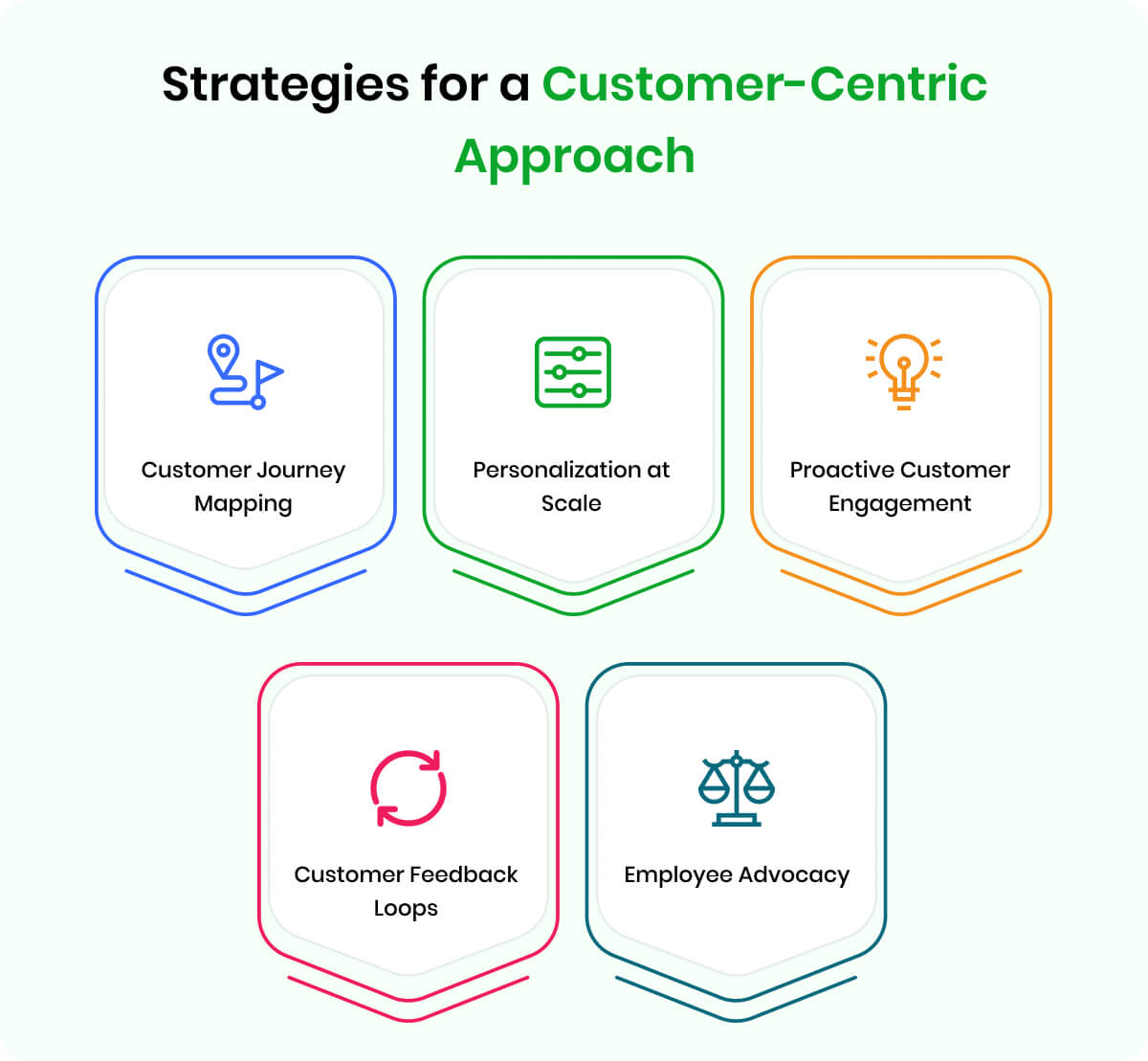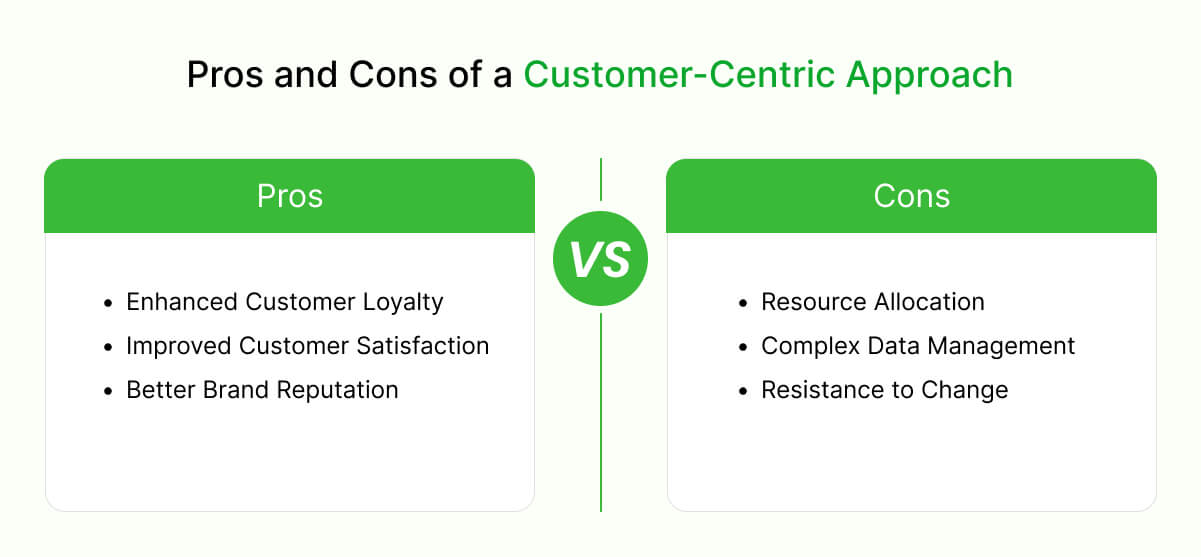 Business Solutions
Business Solutions

27 September, 2023

In order to skyrocket your revenue, you must feel that every decision matters. It’s like standing at a crossroads, where the path you choose will impact your bottom line, your brand, and your future.
It is natural that the business interest lies in creating a bridge between the product and the customer. But what about when it comes to choosing between the two? And this is exactly where the concept of product-centric vs. customer-centric comes into play.
Product-centricity is about creating products that practically sell themselves, captivating the market with their sheer brilliance. On the other side of the spectrum, Customer-centricity shifts the focus from products to people- the customers. It is centered on catering to customer needs.
This isn’t a simple decision; it’s a strategic pivot that can determine your organization’s trajectory. Whether you lean towards any of them, this exploration will equip you to make the choices that align with your objectives.
Join us as we delve into the core of this critical dichotomy- a decision that requires your attention and decisive action.
Contents
Product-centricity is a business strategy that centers on optimizing and perfecting the products or services a company offers. But it goes far beyond merely creating a good product.
It’s about making your product exceptional, so it not only meets but exceeds customer expectations. So, what does it mean in practice?
Well, it’s all about raising the bar when it comes to your product. Think of it as a commitment to quality that knows no bounds. It’s about constantly refining, innovating, and enhancing what you offer so your product stands out and delivers real value.
Now, here’s the thing: Data plays a big role. Product-centric companies are like sponges when it comes to customer feedback and market trends. They listen, learn, and adapt, ensuring they stay relevant in a constantly changing landscape.
But it’s not just about the product itself. It’s also about building a brand known for excellence and durability. It’s about customer loyalty, staying ahead of the competition, and being ready for whatever the market throws your way.
In the pursuit of product excellence, companies can take several strategic steps. Here are three effective ways to fully embrace this perspective:
One of the fundamental ways to adopt this mindset is by allocating resources to research and development. By doing so, companies can continually enhance and innovate their products. This might mean setting up dedicated R&D teams, collaborating with external innovators, or investing in cutting-edge technologies.
To truly embrace this style, it’s crucial to instill a culture of quality throughout the organization. This goes beyond manufacturing or design; it’s about everyone understanding the critical role they play in delivering an exceptional product.
Quality should be a non-negotiable aspect of your company’s DNA. Employees should feel empowered to contribute to the ongoing improvement of products, whether they work in customer service, marketing, or engineering.
Listening to your customers is a cornerstone of this approach. This means having robust feedback mechanisms in place, whether it’s through surveys, online reviews, or direct customer engagement.
Companies should treat customer input as invaluable insights into product improvement. It’s not just about hearing what they have to say; it’s about showing them that you’re dedicated to delivering what they need.
To truly understand how companies can put this approach into practice, let’s take a closer look at a real-world example: Apple Inc.
Apple’s unwavering commitment to innovation is apparent across their product line, from the iconic iPhone to the sleek MacBook. They invest substantially in research and development, consistently pushing boundaries and setting industry benchmarks.
Quality is a fundamental tenet of Apple’s drift. From materials to the user experience, they prioritize excellence at every level of their organization.
Listening actively to customers is a cornerstone of Apple’s success. They proactively gather feedback through various channels, from customer surveys to social media interactions. This customer input informs product enhancements and updates.
The result? A loyal customer base that eagerly anticipates new releases and readily recommends Apple products.
Moreover, they stay ahead of the curve by anticipating and adapting to market trends. They understand the evolving landscape of consumer preferences and respond accordingly.
Customer-centricity isn’t just a business strategy; it’s the heartbeat of a company. It’s about placing the customer at the very core of every decision and operation.
Imagine it as understanding what truly makes customers tick – their needs, preferences, and behaviors. The ultimate goal? Ensuring that at every step of the customer journey, they’re not just satisfied, but thrilled with the value and experiences they receive.
Now, how does this play out in the real world?
First and foremost, it all starts with active listening. Companies that follow this approach dive deep into identifying and fulfilling those unique customer desires. It’s about fitting like a glove, ensuring every aspect aligns seamlessly with what the customer craves.
Then, there’s personalization – like tailoring a suit for each interaction. Every customer touchpoint is uniquely crafted to match individual preferences, creating a one-of-a-kind experience every time.
But it doesn’t end there. It’s an ongoing journey of engagement. Customer-centric companies don’t just make sales and move on. They’re in it for the long haul, viewing every interaction as a chance to build a lasting bond.
A customer-first approach isn’t just a passing trend; it’s a mindset that permeates an organization. It’s built on three fundamental components that shape how a company operates and engages with its customers:
At the heart of this approach lies a profound comprehension of your customer base. This involves identifying distinct customer segments based on behavior, preferences, and needs. It also entails tracing the customer journey from awareness to purchase and beyond.
It’s not enough for a company to say it’s putting customers first; it must live and breathe this ethos. A culture guarantees that everyone within the organization plays a role in delivering exceptional experiences. This involves senior leaders actively championing and modeling customer-centric behaviors.
Data informs strategies, measures performance, and guides improvements. Companies that excel in this component collect comprehensive data on customer behavior, feedback, and interactions across multiple touchpoints. They use data analytics and insights to understand customer trends and preferences.

Implementing a customer-centric approach involves more than just a mindset; it requires actionable strategies. Here, we explore three vital strategies that empower companies to put the customer at the forefront of their operations:
When it comes to exemplifying a customer-centric approach, REVE Chat, a leading live chat software company, stands out as a prime example. Here’s how they put the principles of customer-centricity into action:
At the epicenter of REVE Chat’s dedication to the customer rests a profound understanding of their customer base. They segment their customers based on factors such as company size, industry, and specific needs.
By creating detailed customer personas, they can effectively tailor their product offerings, support, and marketing messages to different segments.
This commitment permeates throughout the organization. Frontline support agents are not only encouraged but empowered to make decisions that prioritize customer satisfaction.
Data, always reigning the industry, plays a fundamental role in REVE Chat’s strategy. They collect comprehensive data on customer interactions, chat transcripts, and user behavior within their software.
Advanced analytics provide insights into customer preferences, common pain points, and feature usage. This data informs product development, enabling them to release updates that align with customer needs and preferences.

While emphasizing product development, features, and quality, this approach really shows its merits. However, it’s not without its drawbacks, and that you need to be aware of.
Let’s get to know what you are going to get in return if you put your product over everything.
Let’s examine some of its drawbacks that you need to keep checking, which can save you from potential issues in the long run.

While putting the customer at the heart of every decision and interaction, it offers numerous advantages. However, it didn’t manage to skip out of its drawbacks.
Let’s see what it has to offer in the case you plan to tag it in the operation of your organization.
Here are the complexities when you aim to thrive in a customer-centric landscape:
This section is going to place these models side by side so that you can have a clear grasp. Appreciating these subtleties is vital for businesses seeking to navigate the dynamic waters of modern markets effectively.
Let’s delve into their key differences that can impact further plan and operational initiatives:
When focusing on product excellence, the spotlight gleams on product development, quality, and innovation. The driving force behind decisions is the relentless pursuit of creating standout offerings.
Centering on customer needs, in stark contrast, the central axis revolves around understanding customer needs, preferences, and behaviors. This perspective shapes every decision, from product design to marketing strategies.
In the case of chasing product brilliance, the ultimate aspiration is to craft products that shine brighter than competitors. The goal is to create offerings that outshine, dazzle, and lead the market.
When developing customer devotion, on the other end, the core objective is nurturing customer satisfaction and cultivating enduring loyalty. The aim is to create experiences that resonate with customers, leading to sustained loyalty.
The choice between product-centric and customer-centric models can significantly impact a company’s trajectory. Let’s uncover three practical insights into when each model is more suitable.
The product-centric approach shines in industries where innovation and technology advancements are paramount. Sectors such as technology, electronics, and cutting-edge gadgets benefit from a relentless focus on product excellence. Customers in these domains crave the latest features and functionalities, making innovation a compelling draw.
In subscription-based models like streaming platforms (e.g., Netflix) or SaaS providers (e.g., Adobe Creative Cloud), you need to think customer-oriented model. Subscribers expect ongoing value for their recurring payments.
You are required to optimize the user experience and continuously address customer feedback. This reduces churn (the rate at which subscribers cancel), and ensures long-term profitability.
You should consider your company’s lifecycle stage; it really gets biased situation-wise. Startups may prioritize product excellence to establish their foothold, while mature businesses might shift towards customer-centric strategies to maintain market share.
Startups typically need to establish their presence in the market by offering a product that stands out, whether through innovation, unique features, or superior quality. As businesses mature and face increased competition, maintaining market share becomes vital.
As the business arena regularly turns to a new dimension, you need to be ready to get used to shifting between product-centricity and customer-centricity. Here are how you can make a smooth and successful shift:
Shift towards a customer-centric approach by meticulously mapping the customer journey and optimizing touchpoints for enhanced customer experiences.
Transition to a customer-centric approach by harnessing the power of data-driven decision-making fueled by customer insights.
Embrace a hybrid approach that strikes a balance between product excellence and customer-centricity.
In the ongoing debate about prioritizing customers or products, the former often emerges as the preferred path for several compelling reasons. Let’s delve into the main motivations behind this choice:
This exploration of the product-centric vs. customer-centric approaches acknowledges that balancing between them is utmost situational. But here’s the essence: Prioritizing your customers is a winning strategy. In this era of constant change, data-driven agility is your superpower.
So, which path suits your business best? Whether you’re seeking balance or a full customer-centric shift, remember that your journey is unique. And for expert guidance tailored to your needs, connect with us today. Together, we can elevate your approach and help you thrive in ever-evolving markets.